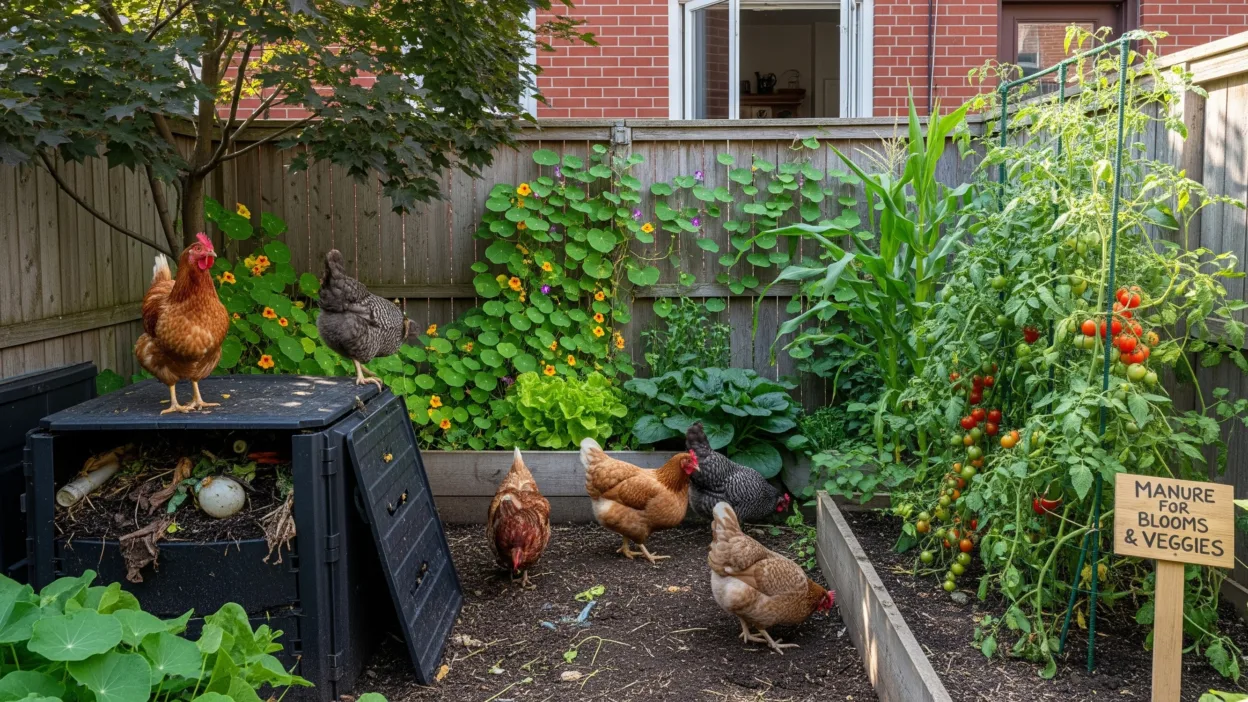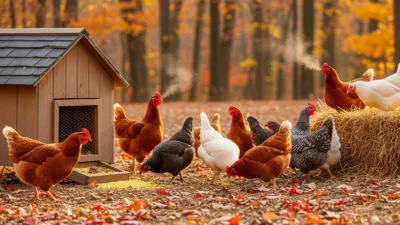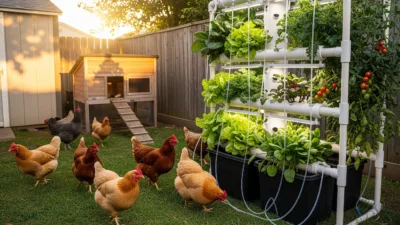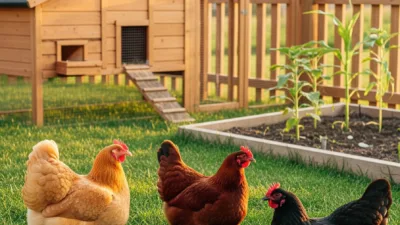Raising chickens in urban and suburban backyards has become one of the fastest-growing homesteading trends in the United States. Beyond the daily reward of fresh eggs, chickens provide something many city gardeners find invaluable: manure.
Chicken manure is packed with nitrogen, phosphorus, and potassium, essential nutrients for vegetables, flowers, and fruit trees. However, because chicken waste is “hot” and can burn plants or harbor pathogens if not handled correctly, it is important to learn safe compost practices.
This guide will walk you through everything you need to know about composting chicken waste safely in an urban setting, from setting up a compost bin to creating nutrient-rich soil that boosts garden productivity.
Why Compost Chicken Waste Instead of Using It Directly
Chicken manure is one of the richest natural fertilizers available. But applying it fresh to your garden can cause problems:
- High nitrogen content: Fresh manure can burn seedlings and sensitive plants.
- Pathogens: Salmonella and E. coli may exist in raw manure if not composted.
- Odor and flies: Directly spreading chicken droppings can attract pests.
Composting solves these issues by allowing heat, microbes, and time to break down the manure into safe, balanced fertilizer.
Setting Up an Urban Compost System for Chicken Waste
When space is limited, your compost setup must be efficient and tidy. Here are several proven options:
1. Enclosed Compost Bins
Urban areas benefit from enclosed composters, such as rotating tumblers or sealed plastic bins. These minimize odors, deter rodents, and keep your neighbors happy.
2. Pallet or Wire Bins
If your city regulations allow, create a compact bin using wooden pallets or galvanized wire. Keep it at least 3 feet by 3 feet to generate enough heat for effective decomposition.
3. Bokashi Composting
For apartments or very small yards, Bokashi bins ferment chicken waste indoors using microbes. Later, the material can be buried in garden beds to finish breaking down.
The Carbon-to-Nitrogen Ratio
Successful composting depends on the balance of “greens” (nitrogen-rich material like chicken manure) and “browns” (carbon-rich materials like straw, wood shavings, or dry leaves).
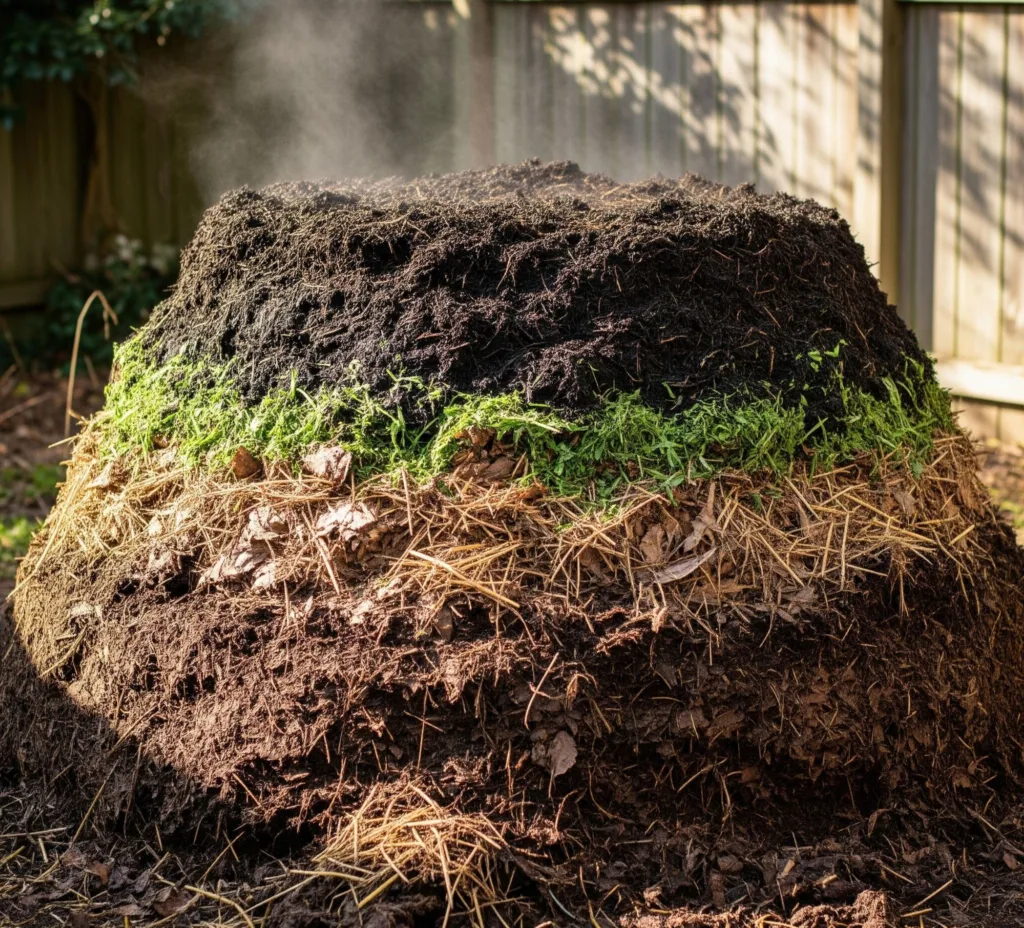
- Ideal ratio: 25–30 parts carbon to 1 part nitrogen.
- Chicken manure alone is too nitrogen-heavy. Pair every shovel of manure with at least 2–3 shovels of bedding or dry carbon material.
This balance helps:
- Reduce odor
- Speed up decomposition
- Prevent flies and excess moisture
Layering Method for Composting Chicken Waste
Urban chicken keepers can adopt a simple layering method:
- Bottom layer: Start with twigs, wood chips, or straw for airflow.
- Add manure and bedding: Collect droppings from the coop and combine with used shavings.
- Cover with browns: Always add a layer of carbon material to reduce smell and discourage pests.
- Turn regularly: Use a garden fork every 1–2 weeks to aerate and distribute heat evenly.
How Long Does Chicken Waste Take to Compost Safely
- Hot composting method: With frequent turning and proper moisture, compost can be ready in 2–3 months.
- Cold composting method: If left to break down naturally, it may take 6–12 months.
Urban gardeners aiming for pathogen-free compost should target a compost pile that reaches 130–150°F (54–65°C) for several days. This heat kills most harmful bacteria.
Safety Precautions for Urban Chicken Waste Composting
Because urban areas have stricter health and neighbor concerns, safety practices are essential:
- Wear gloves when handling manure.
- Wash hands thoroughly after working in the compost.
- Keep pets away from active piles.
- Avoid raw application on edible crops. Compost should age for at least 90 days before use.
- Check local laws: Some municipalities regulate animal waste management.
Reducing Odor and Flies in City Compost
One common concern from neighbors is smell. Keep your compost pile discreet and odor-free by:
- Adding extra browns (leaves, shredded cardboard, sawdust).
- Keeping the pile slightly moist, not soggy.
- Covering fresh manure with bedding immediately.
- Using a compost tumbler for sealed breakdown.
Using Finished Compost in the Garden
Once your compost has turned into dark, crumbly soil with an earthy smell, it’s ready for use. Benefits include:
- Vegetable gardens: Improves soil structure and provides slow-release nutrients.
- Container gardens: Enriches potting soil for patio tomatoes, herbs, and peppers.
- Fruit trees and shrubs: Boosts flowering and fruit production naturally.
- Urban lawns: Lightly top-dress to encourage greener grass without synthetic fertilizer.
Common Mistakes to Avoid
Even experienced chicken keepers sometimes make composting mistakes. Here are a few to watch out for:
- Too much manure: Causes odor and slimy piles. Balance with bedding.
- Not enough aeration: Leads to anaerobic conditions and foul smells. Turn regularly.
- Skipping the curing phase: Applying half-finished compost can harm plants.
- Adding chemicals: Don’t compost bedding with cleaning agents or chemical treatments.
Urban Homesteader Pro Tip
If you don’t have space for a large compost pile, consider partnering with a community garden. Many urban gardens accept chicken waste and bedding to create nutrient-rich compost for shared crops. This reduces waste in your backyard and supports local food systems.
Conclusion
Composting chicken waste in an urban environment is not only possible but also highly beneficial for sustainable gardening. By following safe compost practices, balancing carbon and nitrogen, monitoring moisture, controlling odor, and allowing enough time for curing, you can transform chicken manure into a rich, safe, and eco-friendly fertilizer.
For backyard gardeners across the U.S, especially those with limited space, composting offers a way to close the loop between your chickens and your vegetables. Instead of viewing manure as waste, you can see it as one of the most valuable resources on your urban homestead.
